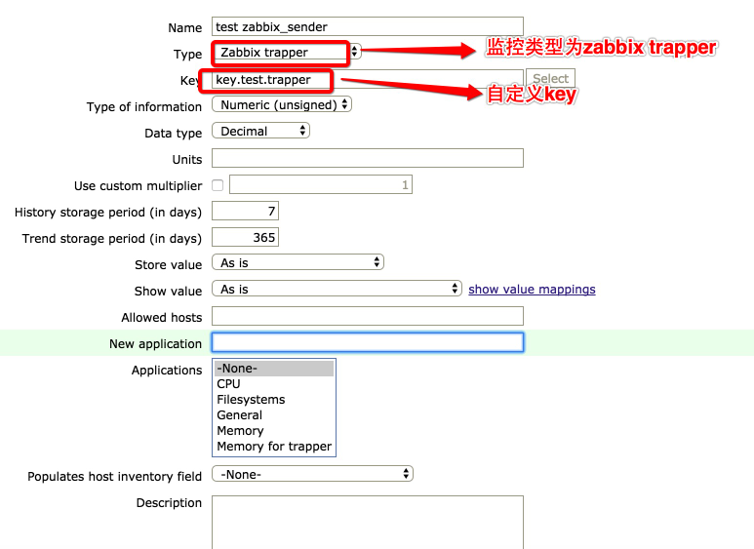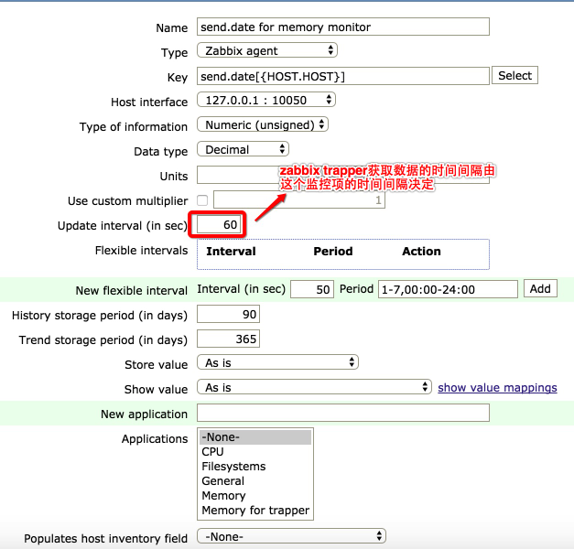3、zabbix_get和zabbix_
发布时间:2019-09-03 08:56:04编辑:auto阅读(2305)
Zabbix_get命令:
zabbix_get是zabbix中的一个程序,用于zabbix-server到zabbix-agent获取数据。通常用来检测agent的配置是否正确。
[root@localhost ~]# zabbix_get -h Zabbix get v2.2.11 (revision 56693) (12 November 2015) usage: zabbix_get [-hV] -s <host name or IP> [-p <port>] [-I <IP address>] -k <key> Options: -s --host <host name or IP> Specify host name or IP address of a host -p --port <port number> Specify port number of agent running on the host. Default is 10050 -I --source-address <IP address> Specify source IP address -k --key <key of metric> Specify key of item to retrieve value for -h --help Give this help -V --version Display version number Example: zabbix_get -s 127.0.0.1 -p 10050 -k "system.cpu.load[all,avg1]"
参数说明:
-s --host: 指定客户端主机名或者IP
-p --port:客户端端口,默认10050
-I --source-address:指定源IP,写上zabbix server的ip地址即可,一般留空,服务器如果有多ip的时候,你指定一个。
-k --key:你想获取的key
至于使用长参数还是短的,自己选,我经常使用-s而不是--host,太长了。
获取CPU负载
[root@localhost ~]# zabbix_get -s 127.0.0.1 -p 10050 -k "system.cpu.load[all,avg15]" 0.000000
key可以加引号,也可以不加。
获取主机名
[root@localhost ~]# zabbix_get -s 127.0.0.1 -p 10050 -k system.hostname localhost.localdomain
Zabbix_sender命令:
zabbix_sender是什么?有什么作用?
zabbix获取key值有超时时间,如果自定义的key脚本一般需要执行很长时间,这根本没法去做监控,那怎么办呢?使用zabbix监控类型zabbix trapper,需要配合zabbix_sender给它传递数据。关于trapper的用法,我们来弄个实例。
执行超长时间脚本,如:脚本去几十台服务器拉去数据,每个日志都上G,然后日志整合在一起,统计出返回值。这种脚本比如超时,所以我们必须改成让客户端提交数据的方式。
zabbix_sender命令用法:
[root@localhost ~]# zabbix_sender -h
Zabbix Sender v2.2.11 (revision 56693) (12 November 2015)
usage: zabbix_sender [-Vhv] {[-zpsI] -ko | [-zpI] -T -i <file> -r} [-c <file>]
Options:
-c --config <file> Absolute path to the configuration file
-z --zabbix-server <server> Hostname or IP address of Zabbix server
-p --port <server port> Specify port number of server trapper running on the server. Default is 10051
-s --host <hostname> Specify host name. Host IP address and DNS name will not work
-I --source-address <IP address> Specify source IP address
-k --key <key>
Specify item key
-o --value <key value> Specify value
-i --input-file <input file> Load values from input file. Specify - for standard input
Each line of file contains whitespace delimited: <hostname> <key> <value>
Specify - in <hostname> to use hostname from configuration file or --host argument
-T --with-timestamps Each line of file contains whitespace delimited: <hostname> <key> <timestamp> <value>
This can be used with --input-file option
Timestamp should be specified in Unix timestamp format
-r --real-time Send metrics one by one as soon as they are received
This can be used when reading from standard input
-v --verbose Verbose mode, -vv for more details
Other options:
-h --help Give this help
-V --version Display version number使用参数:
-c --config <file> 配置文件绝对路径 -z --zabbix-server <server> zabbix server的IP地址 -p --port <server port> zabbix server端口.默认10051 -s --host <hostname> 主机名,zabbix里面配置的主机名(不是服务器的hostname),不能使用ip地址 -I --source-address <IP address> 源IP -k --key <key> 监控项的key -o --value <key value> key值 -i --input-file <input file> 从文件里面读取hostname、key、value 一行为一条数据,使用空格作为分隔符,如果主机名带空格,那么请使用双引号包起来 -T --with-timestamps 一行一条数据,空格作为分隔符: <hostname> <key> <timestamp> <value>,配合 --input-file option,timestamp为unix时间戳 -r --real-time 将数据实时提交给服务器 -v --verbose 详细模式, -vv 更详细
Zabbix_sender使用实例:
先在主机zabbix server 上创建一个key。
传递一个数据到item中,注意-s后面为zabbix_agent.conf文件中配置的hostname,不是IP地址,也不是服务器的主机名。
[root@ZabbixServer alertscripts]# zabbix_sender -s "ZabbixServer" -z 127.0.0.1 -k "key.test.trapper" -o 1 -r info from server: "processed: 1; failed: 0; total: 1; seconds spent: 0.000034" sent: 1; skipped: 0; total: 1
failed为0,表示传送失败的为0个。
zabbix_sender还可以批量上传数据,即将服务器的hostname(zabbix_agent.conf文件中配置的主机名)、key、value三个值保存到文件中,然后将该文件中的数据上传到各个item中。
zabbix_sender批量传递key值
#cat f.txt "Zabbix server" ttlsa.trapper 10 "Zabbix server" ttlsa.trapper 20 "Zabbix server" ttlsa.trapper 30 "Zabbix server" ttlsa.trapper 40 "Zabbix server" ttlsa.trapper 1 # ./zabbix_sender -z 127.0.0.1 -i f.txt info from server: "processed: 5; failed: 0; total: 5; seconds spent: 0.000085" sent: 5; skipped: 0; total: 5
每行对应一个key值,一般是相同的主机名、不同的key、不同的key值。这边方便测试,所以都用了同一个key
这种方式也是zabbix trapper监控方式的模型。
Zabbix Trapper监控案例演示:
创建两个监控项,monitor[TotalMemory]和monitor[FreeMemory],分别用来监控总内存和剩余内存。
监控脚本如下:
#!/bin/bash
hostname=$1
zabbix_server_ip=172.16.206.130
TotalMemory()
{
TotalMemory=`cat /proc/meminfo | awk '/^MemTotal:/{print $2}'`
echo "$hostname monitor[TotalMemory] $TotalMemory"
}
FreeMemory()
{
FreeMemory=`cat /proc/meminfo | awk '/^MemFree:/{print $2}'`
echo "$hostname monitor[FreeMemory] $FreeMemory"
}
TotalMemory >> /tmp/test.txt
FreeMemory >> /tmp/test.txt
zabbix_sender -z $zabbix_server_ip -i /tmp/test.txt &>/dev/null
if [ `echo $?` -eq 0 ];then
echo 0
else
echo 1
fi
rm -rf /tmp/test.txt注意:脚本最后一行是当数据上传完成后删除保存数据的文件,这样下次执行脚本时保证不会有相同的key对应多个value。
zabbix web上创建对应的item
注意:上面我们创建了item,也创建了获取item值的脚本。但是这个脚本不会自动执行,将数据传送到zabbix server上。所以我们还需要再创建一个监控项,这个监控项会定时执行我们创建的脚本。
创建自定义监控的conf文件
[root@ZabbixServer zabbix_agentd.d]# vim userparameter_memory.conf UserParameter=send.date[*],/etc/zabbix/scripts/memory.monitor.sh $1
zabbix server上创建监控项:
上一篇: linux信号解释(3)--信号处理机制
下一篇: H3C OSPF 路由过滤
- openvpn linux客户端使用
51723
- H3C基本命令大全
51383
- openvpn windows客户端使用
41815
- H3C IRF原理及 配置
38586
- Python exit()函数
33067
- openvpn mac客户端使用
30075
- python全系列官方中文文档
28746
- python 获取网卡实时流量
23744
- 1.常用turtle功能函数
23652
- python 获取Linux和Windows硬件信息
22021
- Python搭建一个RAG系统(分片/检索/召回/重排序/生成)
2248°
- Browser-use:智能浏览器自动化(Web-Agent)
2931°
- 使用 LangChain 实现本地 Agent
2448°
- 使用 LangChain 构建本地 RAG 应用
2392°
- 使用LLaMA-Factory微调大模型的function calling能力
2979°
- 复现一个简单Agent系统
2398°
- LLaMA Factory-Lora微调实现声控语音多轮问答对话-1
3203°
- LLaMA Factory微调后的模型合并导出和部署-4
5265°
- LLaMA Factory微调模型的各种参数怎么设置-3
5084°
- LLaMA Factory构建高质量数据集-2
3629°
- 姓名:Run
- 职业:谜
- 邮箱:383697894@qq.com
- 定位:上海 · 松江



